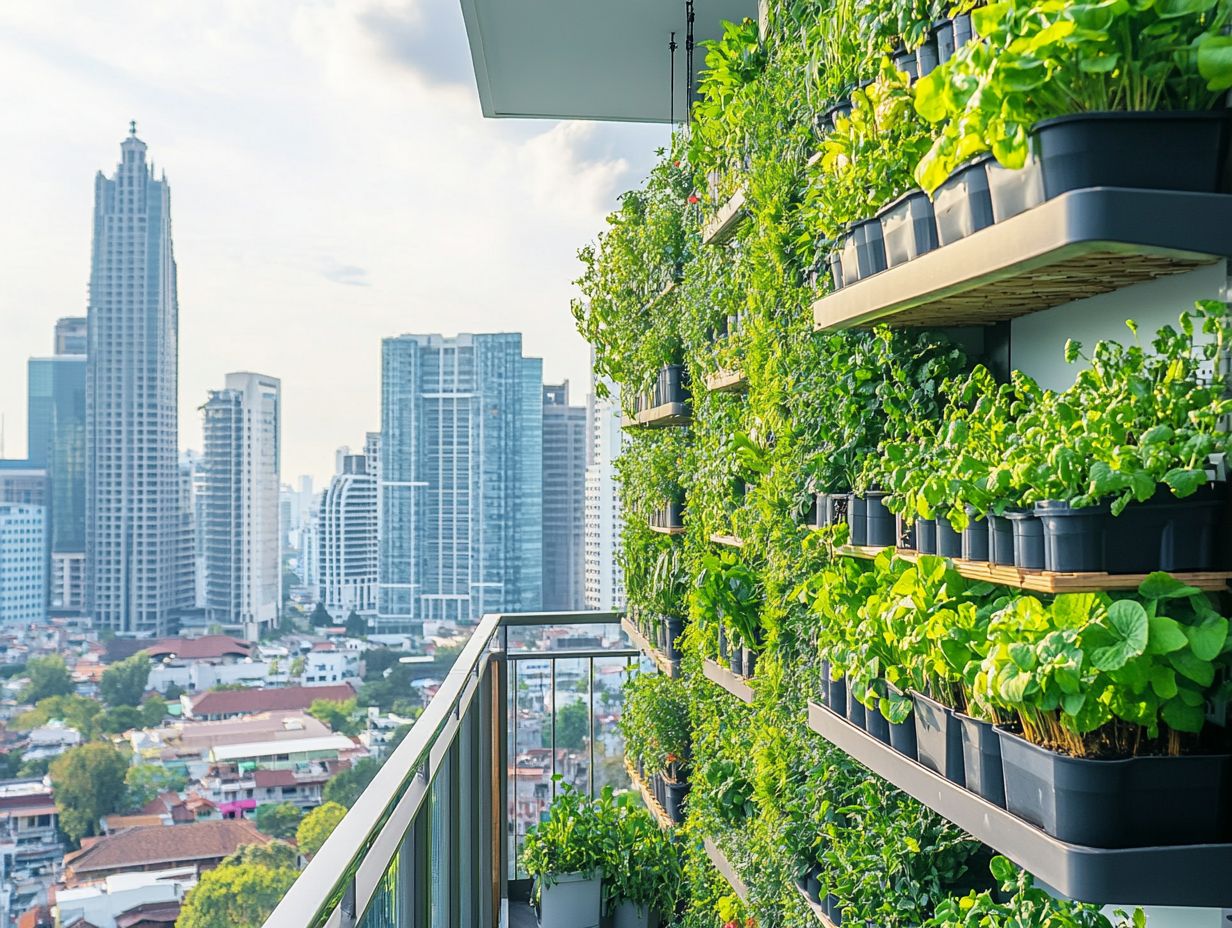How to Implement Hydroponics in Urban Areas?
In a time when urban living is increasingly prevalent, you may find that traditional farming encounters significant hurdles. Enter hydroponics a revolutionary, soil-less growing technique that presents an efficient solution for city dwellers eager to cultivate fresh food right at home!
This article delves into the myriad benefits of hydroponics designed specifically for urban environments. It highlights its ability to save space while minimizing environmental impact. You ll explore various hydroponic systems, receive guidance on setting one up, and tackle the common challenges you might face along the way.
Uncover how you can transform your urban space into a vibrant green oasis by utilizing methods like rooftop farming!
Contents
- Key Takeaways:
- Benefits of Hydroponics in Urban Areas
- Types of Hydroponic Systems
- Setting up a Hydroponic System in an Urban Area
- Challenges and Solutions for Urban Hydroponics
- Frequently Asked Questions
- Curious about how to grow fresh food in your city?
- What is hydroponics and how can it be implemented in urban areas?
- What are the benefits of implementing hydroponics in urban areas?
- Do I need any special equipment to implement hydroponics in urban areas?
- How much maintenance is required for a hydroponic system in an urban area?
- Can anyone implement hydroponics in urban areas or is it only for experienced gardeners?
- Are there any limitations to implementing hydroponics in urban areas?
Key Takeaways:

What is Hydroponics?
Hydroponics is a groundbreaking agricultural technique that gives you the power to grow plants without soil. It uses nutrient-rich water solutions to foster sustainable agriculture.
This exciting system lets you control how plants grow, making it easier to produce food anywhere. It allows you to minimize space while maximizing your crop production potential. It’s especially great for urban farming and rooftop initiatives in densely populated areas. Additionally, schools can benefit from this approach by learning how to incorporate hydroponics into their curriculum.
Though its roots trace back to ancient cultures, hydroponics has undergone a remarkable transformation, especially in the last century, thanks to advancements in technology and agricultural practices. At its core, this method emphasizes precise nutrient management, enabling you to customize conditions that optimize plant growth.
Not only does this conserve water, but it also lessens the reliance on harmful pesticides, resulting in healthier crop yields. In urban settings, where agricultural space is at a premium, hydroponics emerges as a crucial solution, giving communities the power to produce fresh food locally. To maximize success, farmers should consider the best practices for hydroponic farmers.
This approach helps combat food deserts, or areas with limited access to fresh food, and enhances food security. The adaptability of hydroponic systems allows them to be seamlessly integrated into schools and businesses. For more insights, learn how to use hydroponics for food security, nurturing a new generation of environmentally conscious individuals and inspiring sustainable practices.
Benefits of Hydroponics in Urban Areas
The adoption of hydroponics in urban areas presents remarkable advantages. It revolutionizes your approach to food production in densely populated regions.
By harnessing innovative farming techniques, urban farming initiatives allow you to utilize space efficiently through hydroponic systems. This embraces sustainable agricultural practices that conserve water and enhance local food supply chains.
Efficient Use of Space
One of the most compelling advantages of hydroponics is its remarkable efficiency in utilizing space, especially in urban centers where land is at a premium. By incorporating vertical farming techniques and modular designs, hydroponic systems give you the power to maximize agricultural output.
This enables year-round production in even the smallest areas. This method not only conserves valuable urban real estate but also supports sustainable food production, significantly reducing your reliance on long-distance transportation.
With tiered structures, these systems allow for a diverse array of crops to flourish in confined spaces. The modular designs provide you with the flexibility and scalability you need.
By integrating advanced technologies like automated nutrient delivery and climate control, you can further optimize growing conditions, boosting productivity. To enhance your efforts, learn how to make hydroponic gardening sustainable. As urban agriculture gains momentum, these innovative strategies will undoubtedly play a crucial role in satisfying the food demands of rapidly growing city populations.
Reduced Environmental Impact

Hydroponics is a great way to reduce your environmental impact. It embraces sustainable practices that conserve water and minimize pesticide use.
This innovative food-growing method lowers carbon dioxide emissions while enhancing ecosystem services. It’s a viable solution to combat climate change.
Hydroponics uses a closed-loop system that recirculates water, allowing you to save up to 90% of it. This efficiency helps conserve precious freshwater resources.
With less reliance on synthetic pesticides, this method promotes healthier food production and creates a safer environment for pollinators. These advantages make hydroponics an innovative approach to sustainable farming.
Types of Hydroponic Systems
Explore different types of hydroponic systems, including aquaponics. Each system is designed to meet specific agricultural needs.
Aquaponics merges fish farming with hydroponics. Alternatively, vertical farming systems make the most of indoor agriculture.
Understanding these systems is vital for effective urban farming.
Comparison and Suitability for Urban Areas
When comparing hydroponic systems, evaluate their suitability for urban farming. Some systems excel in space efficiency and crop production.
Others may require a larger initial investment or specialized knowledge. For instance, the nutrient film technique (NFT) optimizes water use and minimizes waste, but it s not the easiest option for beginners.
Vertical farming systems can maximize land use by stacking crops. However, they may present challenges with energy consumption and costs.
As you consider adopting agricultural technology, weigh these factors carefully. Finding the balance between food production and resource demands is crucial for successful urban agriculture.
Setting up a Hydroponic System in an Urban Area
Setting up a hydroponic system in an urban area can be rewarding. It fosters local food production and promotes sustainable practices.
To succeed in indoor farming, gather essential materials while considering climate conditions and available land. Additionally, learning how to scale up your hydroponic garden can significantly enhance your gardening efforts.
Materials and Resources Needed

You will need key materials for your hydroponic system: nutrient-rich water solutions, suitable growing media, and the right containers. Focus on nutrient control and water conservation for efficiency.
Tanks are vital for storing nutrient solutions, ensuring your plants get the hydration they need. Pumps circulate water and nutrients, keeping each plant supplied.
Choose the right growing media, like clay pellets or rock wool. A pH control kit helps maintain optimal conditions for plant growth and nutrient absorption.
Step-by-Step Guide
Setting up a hydroponic system requires careful planning and execution, especially in urban farming. This step-by-step guide is designed to cover all the key pieces you need for success, ensuring you cultivate a flourishing indoor farming environment.
In bustling urban spaces, where every square inch counts, you might find yourself seeking innovative ways to grow your own food. Hydroponics presents a space-efficient solution by using nutrient-rich water instead of soil to nurture your plants. Learning how to integrate hydroponics into your lifestyle can further enhance your gardening experience.
- Begin by selecting the right system type whether it’s nutrient film technique, deep water culture, or aeroponics tailored to your available space and the specific plants you wish to grow.
- Next, identify a suitable location that offers ample light, such as a sun-drenched window or efficient grow lights.
- Gather all necessary equipment, including pumps, reservoirs, and grow trays, ensuring that each component is compatible and operates efficiently.
- Once your setup is complete, focus on nutrient management and monitor plant health closely to foster optimal growth.
Challenges and Solutions for Urban Hydroponics
Urban hydroponics introduces a range of challenges, from resource limitations to varying climate conditions. Effectively managing these issues is crucial for fostering sustainable practices that enhance food security and adapt seamlessly to climate change.
Addressing Potential Issues
It’s essential to address potential issues in urban hydroponics to maintain optimal food production levels. Challenges like nutrient imbalances, water quality, and environmental controls must be managed precisely for successful crop growth.
Consider the specific needs of various crops and grasp the dynamics of urban environments. Implement tailored strategies for enhanced productivity. For instance, regularly monitoring nutrient solutions can prevent deficiencies that may jeopardize plant health. By investing in advanced water purification systems, you can assure quality while conserving resources. Additionally, learning how to use hydroponics for indoor gardening can make your hydroponic endeavors more sustainable.
You can implement automated climate control systems to maintain ideal light, temperature, and humidity levels, creating a flourishing environment for your crops. If you’re interested in getting started with this method, check out how to start hydroponic gardening at home. By tackling these interconnected concerns, you can cultivate successful vertical gardens and contribute significantly to food security in metropolitan areas.
Frequently Asked Questions

Curious about how to grow fresh food in your city?
What is hydroponics and how can it be implemented in urban areas?
Hydroponics is a method of growing plants without soil, using a mineral nutrient solution in water. You can implement it in urban areas by utilizing vertical farming techniques, indoor gardening, or rooftop gardens.
What are the benefits of implementing hydroponics in urban areas?
There are several benefits to using hydroponics in urban areas, including saving space, reducing water usage, and producing higher yields. It also allows for year-round production and eliminates the need for pesticides.
Do I need any special equipment to implement hydroponics in urban areas?
Yes, you ll need a few essentials like a hydroponic system, grow lights, and a nutrient solution. These can be easily set up in small spaces or purchased as ready-to-use kits.
How much maintenance is required for a hydroponic system in an urban area?
Hydroponic systems require minimal maintenance compared to traditional soil-based gardening. Plants need regular monitoring, and the nutrient solution may need replenishment, but overall it s a low-maintenance option.
Can anyone implement hydroponics in urban areas or is it only for experienced gardeners?
Hydroponics can be implemented by anyone, regardless of gardening experience. Many resources are available online and through local workshops to help beginners get started.
Don t wait! Start your hydroponic garden today and enjoy fresh produce year-round!
Are there any limitations to implementing hydroponics in urban areas?
Urban hydroponics can be a game-changer! One limitation is the starting costs of equipment. However, this can be balanced out by saving money on water and getting more crops.
Access to natural light might be limited in urban areas. Therefore, different lights may be necessary for plants to thrive.






